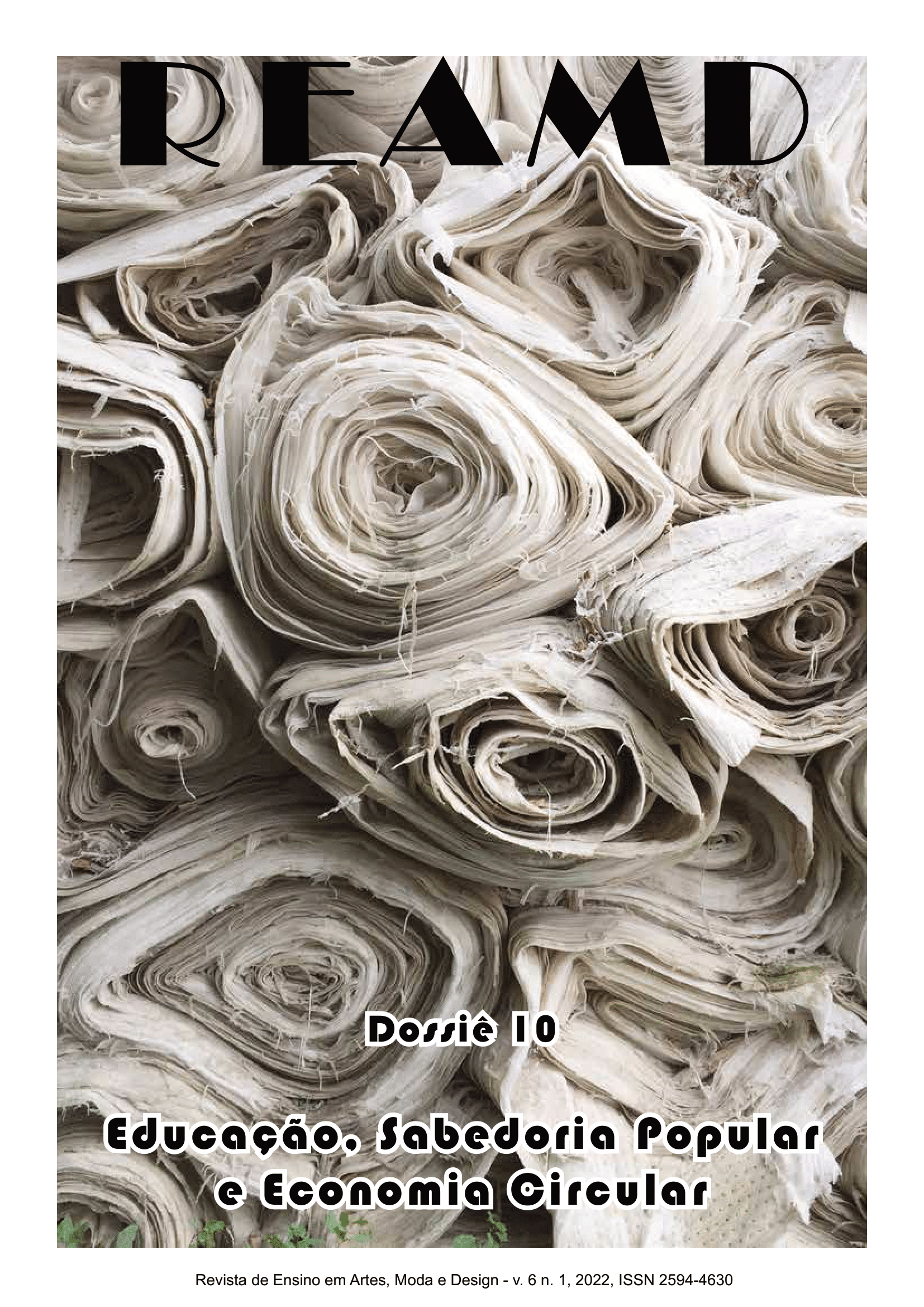Discursividades sobre moda agênero em Vogue Brasil no ano de 2020
DOI:
https://doi.org/10.5965/25944630612022e0144Parole chiave:
Análise de discurso, Vogue Brasil, Moda AgêneroAbstract
O artigo busca investigar, por meio do método da análise de discurso de linha francesa, o modo como é feita a abordagem discursiva sobre moda agênero na revista Vogue Brasil, considerando-se, para isso, as edições veiculadas no período de janeiro a junho de 2020, nas quais se encontram cinco abordagens sobre o tema, distribuídas em três matérias e dois editoriais. Vale destacar que Vogue Brasil é hoje o único título impresso especializado em moda no Brasil a circular mensalmente. Destaca-se na produção de matérias, colunas e editoriais sobre o cenário da moda nacional e internacional e se associa a estruturas discursivas hegemônicas e dominantes de moda, acompanhando os discursos encabeçados por grandes marcas, entre eles, o da moda agênero, que vem despertando a atenção de criadores desde 2015. A despeito de a cobertura sobre agênero se mostrar presente nas páginas de Vogue Brasil pode-se observar, entretanto, que a publicação não se descola de um padrão de cobertura de moda que a acompanha desde sua origem no Brasil e que pode estar relacionado à manutenção de um status quo que legitima relações de poder ainda dominantes na relação entre gênero e vestimenta no cenário da moda nacional.
Downloads
Riferimenti bibliografici
BRANDÃO, Helena H. Nagamine. Introdução à análise do discurso. Campinas: Unicamp, 2012
BRANDÃO, Ignácio de Loyolla. Vogue: Bom Gosto e sofisticação. In Cadernos da Comunicação – Mulheres em Revista: O Jornalismo Feminino no Brasil. Rio de Janeiro: Secretaria Especial de Comunicação, 2002.
BARNARD, Malcom. Moda e Comunicação. Rio de Janeiro: Rocco, 2003
CRANE, Diana. A moda e seu papel social. São Paulo: Senac, 2006.
FOUCAULT, Michael. A Arqueologia do Saber. Rio de Janeiro: Forense Universitária, 1986.
GOMES, Mayra. As materialidades e seus discursos. Revista Comunicação, Mídia e Consumo. V. 16, N. 46, P. 271-290. São Paulo: ESPM, 2019.
HOLLANDER, Anne. O sexo e as roupas. Rio de Janeiro: Rocco, 1996.
JOFFILY, Ruth. O Jornalismo e Produção de Moda. Rio de Janeiro: Nova Fronteira, 1991.
MAINGUENEAU, Dominique. Novas tendências em análise do discurso. Campinas: Pontes, 1997.
MAINGUENEAU, Dominique. Gênese dos Discursos; São Paulo: Parábola Editorial, 2008.
MARQUES, Ângela Cristina Salgueiro. Comunicação, estética e política: a partilha do sensível promovida pelo dissenso, pela resistência e pela comunidade. Revista Galáxia. nº 22, p.25-39. São Paulo: PUC-SP, 2011.
MEDINA, Cremilda. Notícia: um produto à venda. São Paulo: Summus. 1988.
MELLO E SOUZA, Gilda. O Espírito das Roupas. São Paulo: Companhia das Letras, 2005.
RANCIÈRE, Jacques. O espectador emancipado. São Paulo: 34, 2012.
SCHMITT, Juliana. Santos; Gabriel. Moda sem gênero: conceituação e contextualização das tendências não binárias. In: Anais do 12 Colóquio de Moda. João Pessoa: 2016.
Fontes:
Revista Vogue. Nem eles, nem elas. n 498, p. 46. São Paulo: Condé Nast.
Revista Vogue. Uma coisa só. n 499, p.61-62. São Paulo: Condé Nast.
Revista Vogue. Paixão visceral. n 499, p.94. São Paulo: Condé Nast.
Downloads
Pubblicato
Come citare
Fascicolo
Sezione
Licenza
Copyright (c) 2022 Carina Rufino

TQuesto lavoro è fornito con la licenza Creative Commons Attribuzione 4.0 Internazionale.
- Gli autori conservano i diritti d'autore e concedono alla rivista il diritto della prima pubblicazione, con l'opera simultaneamente licenziata sotto la Licenza Creative Commons Attribuzione 4.0 Internazionale, la quale permette:
1. Condividere — copiare e ridistribuire il materiale su qualsiasi supporto o in qualsiasi formato, per qualsiasi fine, anche commerciale.
2. Adattare — remixare, trasformare e creare a partire dal materiale per qualsiasi fine, anche commerciale. Il licenziante non può revocare questi diritti finché vengono rispettati i termini della licenza.
In accordo con le seguenti condizioni:
1. Attribuzione — È necessario attribuire la paternità dell'opera in maniera appropriata, fornire un link alla licenza e indicare se sono state effettuate delle modifiche. Questo deve essere fatto in qualsiasi circostanza ragionevole, ma non in modo tale che suggerisca che il licenziante avalli l'utilizzatore o il suo utilizzo.2. Nessuna restrizione aggiuntiva — Non è possibile applicare termini legali o misure tecnologiche che limitino legalmente altri dallo fare qualsiasi cosa la licenza permetta.
-
Il plagio, in tutte le sue forme, costituisce un comportamento editoriale eticamente scorretto ed è inaccettabile. Questa rivista utilizza il software di controllo della similarità iThenticate.






